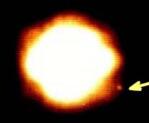Astronomy:41 Daphne
 | |
| Discovery[1] | |
|---|---|
| Discovered by | H. Goldschmidt |
| Discovery date | May 22, 1856 |
| Designations | |
| (41) Daphne | |
| Pronunciation | /ˈdæfni/[2] |
| Named after | Daphnē |
| 1949 TG | |
| Minor planet category | Main belt |
| Adjectives | Daphnean /ˈdæfniən/[3] |
| Orbital characteristics[1] | |
| Epoch 31 December 2006 (JD 2454100.5) | |
| |{{{apsis}}}|helion}} | 3.517 AU (526.144 Gm) |
| |{{{apsis}}}|helion}} | 2.014 AU (301.220 Gm) |
| 2.765 AU (413.682 Gm) | |
| Eccentricity | 0.272 |
| Orbital period | 4.60 a (1,679.618 d) |
| Mean anomaly | 247.500° |
| Inclination | 15.765° |
| Longitude of ascending node | 178.159° |
| 46.239° | |
| Known satellites | Peneius /pɛˈniːəs/ (S/2008 (41) 1) |
| Physical characteristics | |
| Dimensions | c/a = 0.65±0.08[4] 213×160 km[5] 239x183x153 km[6] |
| Mean diameter | 187±13 km[4] 205.5±1.9[1] 189 km[7] |
| Mass | (6.1±0.9)×1018 kg[4] ≈ 6.8×1018 kg[8] |
| Mean density | 1.78±0.45 g/cm3[4] ≈ 1.95 g/cm³[6] |
| Rotation period | 5.9 hr[1] |
| Geometric albedo | 0.052 (calculated)[4] 0.083[1] |
| C [1] | |
| Absolute magnitude (H) | 7.12[1] |
Daphne (minor planet designation: 41 Daphne) is a large asteroid from the asteroid belt.[1] It is a dark-surfaced body 174 km in diameter is probably composed of primitive carbonaceous chondrites. The spectra of the asteroid displays evidence of aqueous alteration.[9] It was discovered by H. Goldschmidt on May 22, 1856, and named after Daphne, the nymph in Greek mythology who was turned into a laurel tree. Incorrect orbital calculations initially resulted in 56 Melete being mistaken for a second sighting of Daphne. Daphne was not sighted again until August 31, 1862.[10]
The orbit of 41 Daphne places it in a 9:22 mean motion resonance with the planet Mars. The computed Lyapunov time for this asteroid is 14,000 years, indicating that it occupies a chaotic orbit that will change randomly over time because of gravitational perturbations of the planets.[11]
In 1999, Daphne occulted three stars, and on July 2, 1999, produced eleven chords indicating an ellipsoid of 213×160 km.[5] Daphnean lightcurves also suggest that the asteroid is irregular in shape. Daphne was observed by Arecibo radar in April 2008.[12][13] Based upon radar data, the near surface solid density of the asteroid is 2.4+0.7−0.5 g cm−3.[14]
Satellite
 Daphne and Peneius as seen by the W.M. Keck II telescope in 2008 | |
| Designations | |
|---|---|
| (41) Daphne I Peneius | |
| Pronunciation | /pɛˈniːəs/ |
| S/2008 (41) 1 | |
| Adjectives | Peneian /pɛˈniːən/ |
| Orbital characteristics | |
| Inclination | ° |
41 Daphne has at least one satellite, named Peneius (provisionally S/2008 (41) 1).[15][16] It was identified on March 28, 2008, and has a projected separation of 443 km, an orbital period of approximately 1.1 days,[6] and an estimated diameter of less than 2 km. If these preliminary observations hold up, this binary system has the most extreme size ratio known.[17]
In Greek myth, Pēneios is the god of the river of that name, and father of Daphne.
References
- ↑ 1.0 1.1 1.2 1.3 1.4 1.5 1.6 1.7 Yeomans, Donald K., "41 Daphne", JPL Small-Body Database Browser (NASA Jet Propulsion Laboratory), https://ssd.jpl.nasa.gov/sbdb.cgi?sstr=41, retrieved 2013-04-07.
- ↑ "Daphne". Daphne. Oxford University Press. http://www.lexico.com/definition/Daphne.
- ↑ Daphne (3rd ed.), Oxford University Press, September 2005, http://oed.com/search?searchType=dictionary&q=Daphne (Subscription or UK public library membership required.)
- ↑ 4.0 4.1 4.2 4.3 4.4 P. Vernazza et al. (2021) VLT/SPHERE imaging survey of the largest main-belt asteroids: Final results and synthesis. Astronomy & Astrophysics 54, A56
- ↑ 5.0 5.1 "1999 European Asteroidal Occultation Results". euraster.net (a website for Asteroidal Occultation Observers in Europe). 2009-02-09. http://www.euraster.net/results/1999/index.html. (1999-Jul-02 Chords)
- ↑ 6.0 6.1 6.2 Conrad, Al; Carry, B.; Drummond, J. D.; Merline, W. J.; Dumas, C.; Owen, W. M. et al. (2008). "Shape and Size of Asteroid (41) Daphne from AO Imaging". American Astronomical Society 40 (28.12): 438. Bibcode: 2008DPS....40.2812C. http://www2.keck.hawaii.edu/inst/people/conrad/research/pub/dps08oct2008v4b.pdf.
- ↑ Matter, Alexis; Marco Delbo; Sebastiano Ligori; Nicolas Crouzet; Paolo Tanga (2011). "Determination of physical properties of the asteroid (41) Daphne from interferometric observations in the thermal infrared". Icarus 215 (1): 47–56. doi:10.1016/j.icarus.2011.07.012. Bibcode: 2011Icar..215...47M.
- ↑ Using the volume of an ellipsoid of 239x183x153km * a density of 1.95 g/cm³ yields a mass (m=d*v) of 6.8E+18 kg
- ↑ Fornasier, S. et al. (February 1999), "Spectroscopic comparison of aqueous altered asteroids with CM2 carbonaceous chondrite meteorites", Astronomy and Astrophysics Supplement 135: 65−73, doi:10.1051/aas:1999161, Bibcode: 1999A&AS..135...65F.
- ↑ Appletons' annual cyclopaedia and register of important events of the year: 1862. New York: D. Appleton & Company. 1863. p. 173. https://archive.org/stream/1862appletonsan02newyuoft#page/n180/mode/1up.
- ↑ Šidlichovský, M. (1999), Svoren, J.; Pittich, E. M.; Rickman, H., eds., "Resonances and chaos in the asteroid belt", Evolution and source regions of asteroids and comets : proceedings of the 173rd colloquium of the International Astronomical Union, held in Tatranska Lomnica, Slovak Republic, August 24–28, 1998: pp. 297–308, Bibcode: 1999esra.conf..297S.
- ↑ Mike Nolan (2012-01-18). "Scheduled Arecibo Radar Asteroid Observations". Planetary Radar at Arecibo Observatory. http://www.naic.edu/~pradar/sched.shtml.
- ↑ "Radar-Detected Asteroids and Comets". NASA/JPL Asteroid Radar Research. http://echo.jpl.nasa.gov/asteroids/.
- ↑ Magri, C. et al. (December 2001), "Radar constraints on asteroid regolith compositions using 433 Eros as ground truth", Meteoritics & Planetary Science 36 (12): 1697–1709, doi:10.1111/j.1945-5100.2001.tb01857.x, Bibcode: 2001M&PS...36.1697M.
- ↑ "MPEC 2019-E58 : SATELLITE OF (41) Daphne". IAU Minor Planet Center. 2019-03-06. https://www.minorplanetcenter.net/mpec/K19/K19E58.html.
- ↑ "IAUC 8930: COMET P/2006 B7 (ODAS); S/2008 (41) 1; 196P; STEREO SPACECRAFT". IAU Central Bureau for Astronomical Telegrams. 2008-03-31. http://www.cbat.eps.harvard.edu/iauc/08900/08930.html#Item2.
- ↑ "Discovery of an Extreme Mass-Ratio Satellite of (41) Daphne in a Close Orbit". Lunar and Planetary Institute. 2008. http://www.lpi.usra.edu/meetings/acm2008/pdf/8370.pdf.
External links
- Asteroids with Satellites, Robert Johnston, johnstonsarchive.net
- 41 Daphne at AstDyS-2, Asteroids—Dynamic Site
- 41 Daphne at the JPL Small-Body Database
vec:Lista de asteroidi#41 Dafne
 |

